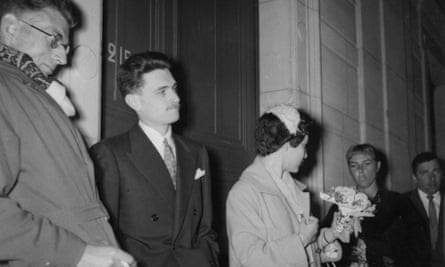A telegram sent by Samuel Beckett to James Joyce on his 49th birthday, 91 years ago today, has been given to the University of Reading by Joyce’s grandson and his wife.
The missive, in which the Waiting for Godot author tells his friend: “Teems of times and happy returns. Beckett”, is part of a major collection of books and documents given by Stephen James Joyce and his wife Solange to the university. The donation, which also includes a photograph of Solange and Stephen James Joyce at their wedding, with an awkward-looking Beckett, who was the best man, was announced to mark the centenary of the publication in Paris of Joyce’s seminal novel Ulysses, as well as the 140th anniversary of Joyce’s birth.
“The unusual birthday telegram from Beckett to Joyce says much about them as friends. Short and sweet, the playful language hints at a shared sense of humour and shows the respect Beckett had for the writer who greatly influenced his own writing style,” said Dr Mark Nixon, an English Literature researcher at the University of Reading and co-director of its Beckett International Foundation.

“The new collection silverplates the relationship we knew existed between Beckett and Joyce, with their personal correspondence shedding fresh light on the closeness between the two. Such gems among the collection will prove invaluable to those studying these two historic writers.”
The university is already home to the Samuel Beckett Collection. Edward Beckett, the nephew of Samuel Beckett, said it was “wonderful to have the Beckett and Joyce archives together under the same roof”. “The two writers were close friends and their estates and families had also stayed close. That it was possible to unite their literary archives is an achievement to applaud,” he added.
Almost 900 letters to and from Joyce are included in the collection, the majority of them unpublished, including missives from Beckett, HG Wells, and around 100 from Joyce’s supporter Harriet Shaw Weaver.
“There are two or three letters that speak to his struggles to get out of Vichy France in 1940, which was an incredibly fraught time for him. It took him at least three months to get the paperwork sorted out in order to leave France and to get the visa to enter Switzerland, at the end of 1940. And, of course, Joyce died a month later in Switzerland. So one of the last things he does is to get his family out of occupied France,” said Nixon. “This is material from very late in in Joyce’s life, that we don’t have that much of, which makes it exciting.”
The collection also includes a copy of the poem Ecce Puer handwritten by Joyce to mark the birth of Stephen Joyce, and a Christmas present from Joyce to his wife Nora, in which he copied out his poetry collection Chamber Music for her. “It’s really quite astonishing,” said Nixon. “It’s a really beautiful sign of his love for Nora. Together with a lot of the personal items and the letters that he wrote to Stephen, it really shows Joyce as a family man, not just this literary giant. A lot of these items show him at his most human.”
The University of Reading intends to make the archive publicly available to scholars. “James Joyce was a writer who transformed our ideas about the world, about creativity and about humanity. His letters, manuscripts and artefacts are rightly treasured but we are taking this collection not just to protect it but to share it,” said Professor Robert Van de Noort, vice-chancellor of the institution.
